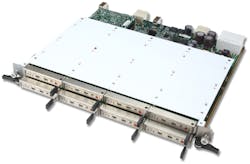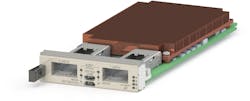Changing The Game: Combining Heavy Processing And Versatility In A Modular Compact Embedded Platform
There is a gap in filling the needs of today’s embedded computing systems, but a critical one. The sweet spot for a solution would be to have the significant performance power of a Haswell, IvyBridge, or similar processors with the key elements of today’s modular open standards. This includes inherent shelf management and redundancy options, reasonably compact size, I/O options, multi-vendor ecosystem and a competitive price. This would fill a significant need from Mil-Aero applications such as RADAR and SIG-INT to Communications-based LTE platforms, to research/lab and high-end computing requirements.
Mind the Gap
In the embedded arena, with AdvancedTCA’s large 8U by 280-mm board size, you have a form factor that provides only a few scaling options and an architecture geared towards heavy-duty processing. With up to 40G fabric speeds across a backplane and high-end x86 (Intel Architecture, IA) processor boards available, ATCA provides the horsepower. But, in some applications the size and limited versatility can be an issue.
A pizzabox solution from one of the major commercial computer companies falls short on many fronts (performance, swappability, multi-vendor versatility, etc). MicroTCA can utilize Xeon E3 and QorIQ P5020 processors for a lot of performance and otherwise meets all of the requirements above. (A 40 Gigaabit Ethernet specification is in draft in the PCI Industrial Manufacturers Group -PICMG). But, for the heavy duty processors that require more than 100W of power per module, there is a snag. With the 7-A @ 12-V limitation, the power defined in the specification would reach its limits. You could design a couple of Haswell chips into an Advanced Mezzanine Card (AMC), but how would you supply the power and still meet the specification?
VPX in 3U or 6U Eurocard form factor almost fits the bill. It has the power flexibility (3.3 V, 5 V, 12 V) to handle the hotter chipsets, but it is very rarely used outside of Mil/Aero because of the hefty price tag. Plus, interoperability is a major challenge and shelf management is not standard – only available in certain vendor-specific solutions. With sequestration and budget cuts, even Defense programs are looking for more cost-effective solutions.
Designing the Best of Both Worlds
It would be ideal to combine the versatility of MicroTCA with the high-end Intel Architecture dual socket Xeon core and power of AdvancedTCA. One existing solution is to utilize an AdvancedTCA chassis with AMC carriers. The AMCs are approximately 75mm (or 150mm in double width) sized modules that plug into an ATCA carrier (Fig. 1). They come in literally hundreds of types/configurations in a standard form-factor from various vendors. This includes processors, GPGPUs, FPGAs, serial IO, NPUs, storage, power, and other modules. It is true COTS architecture since the AMCs are used in all types of applications and the economies of scale keeps the prices quite low. Providing the versatility of MicroTCA’s AMCs and AdvancedTCA powerful processing is a compelling combination.
The Catch
The one limitation with the AdvancedTCA chassis with an AMC carrier is the number of modules you can fit. A carrier can hold 8 compact-size (3HP) modules or 4 full-heights, but there are very limited options of AMCs available in those form factors. Only so many solutions (with only so much functionality) can work on such a small board pitch or you lose 4 slots and are left with 4 full-height slots. The most common AMC pitch is the mid-size (4HP). Even high-end multi-core processors and high-end FPGA (such as Virtex-7) fit in the mid-size AMC. Today, you can fit 4 mid-sized AMCs on a carrier. It would be ideal to have the functionality of more AMCs.
Removing the limitation
With a creative design, it is possible to configure the spacing within a 3U ATCA chassis to fit up to 8 mid-sized AMCs (Fig 2). This provides significantly more possibilities and double the AMC performance density. With 40G Ethernet or x8 Gen 3 PCI Express signals, it is possible to have significant performance in a 3U solution.
Imagine having 8 slots for FPGAs, NPUs, or other AMCs. With today’s AMCs the design engineer can utilize high-end Tilera, Cavium, or other NPUs or even a 100G FPGA AMC (Fig. 3). Theoretically in such a system, the designer can have a 5 Virtex-7 FPGA for A/D conversion, a Core I PrAMC for pre-processing, and a Haswell dual socket Xeon core ATCA processor for heavy-processing. Oh yes, and there would be 2 spare AMC’s for IO, graphics, storage, etc.
Fixing a Hole
MicroTCA/AMC has a lot of other features for designers to use across various applications. This includes carrier locators, JTAG for easy test/development, shelf and FRU management, telco alarms, and more.
There has long been a hole in what engineers can utilize to solve their design problems. Getting the right mix of versatility and powerful processing is always a challenge. Using some creativity, a low-profile 3U ATCA platform can offer a vast array of AMC’s to achieve a wide range of computing goals. It is possible to incorporate the elements of smaller size, shelf management and reliability, hot-swappability/failover, versatility of modules and vast processing power in a modular open standard that is cost-effective.
About the Author

Justin Moll
Vice President of Sales & Marketing, Pixus Technologies
Justin Moll is the Vice President of Sales & Marketing for Pixus Technologies and has been with the company since 2012. He’s active in trade associations such as VITA and PICMG and served as the Vice President of Marketing for PICMG. Justin has been a keynote speaker and featured commentator at multiple embedded computing industry events.



